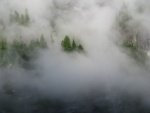Schuster":1tz2ljf3 said:
Hi all,
I am not a C-Dory owner yet but am trying to find a 25' so if you know someone who is getting ready to part with theirs Im all ears.
Now one comment I read is that C-dorys are known for drippy cabin syndrome. Is there a solution for this? Can the inside of the cabin be painted with a moisture block or felt be applied to the bulkheads or overhead?
Thanks
Dave Schuler
Key is understanding the difference between TOTAL and RELATIVE humidity. Total humidity is water dissolved into the air. Relative humidity is what you feel, and related to the ability of water to dissolve into or precipitate, out of the air, onto you, your windows, and your cabin interior.
The figure below shows temperature and the total amount of water that can be dissolved into air before it starts to precipitate out of the water (100% relative humidity). Water can also condense onto colder surfaces in the cabin, and then drip from them, which is what you are trying to avoid. C-Dories are bad because their simple cabin construction and large, single-paned windows, allow the interior to cool...just touch a window or wall on a cold day.

Drippy C-Dory cabins (particularly in the PNW) are caused by water in cabin air having higher total humidity than the temperature of air can hold. Heating air in your cabin without exchanging cabin with outside air only reduces relative humidity, not total, and only temporarily. When that air cools, water can condense from it.
What you need is to either remove humidity (I use a 12 volt dehumidifier), or bring in some outside air, which will typically have a low total humidity, and thus, when heated, a much lower relative humidity. For instance, if you bring in outside air at 40 F, 100% relative humidity and heat it to 60 F, the relative humidity will be about 50%. This will mix with and dry humid cabin air.
Sealing up your cabin nearly air-tight, which is a C-Dory feature many small boats don't have, doesn't work, as we are constantly adding water to the air by breathing, perspiring, and sometimes cooking. LP heaters (i.e. "Buddy" heaters) that don't exhaust to the outside also add water as a combustion product.
The Wallas heater is better, as it takes in cabin air for combustion, and then exhausts it outside. Outside air comes in to replace it, and when heated, dries your cabin because it will likely have lower total humidity.
I keep my Wallas on almost all of the time I am in the cabin. This works. Colder, outside air in the PNW seems wet, as it is usually near 100% relative humidity, but when heated, even a little, will typically be much lower in relative humidity, and when this heated, outside air is mixed with cabin air, will likely dry your cabin.


